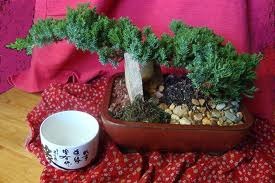 Since bonsai are grown from ordinary, not dwarf, species, their small size is primarily the result of pruning, both branches and roots.
Since bonsai are grown from ordinary, not dwarf, species, their small size is primarily the result of pruning, both branches and roots.
Though much learning and experience is required for proper soil preparation, watering and other needed skills, no other aspect is so critical for making the bonsai more than just a small tree. It’s the key to making it a fine work of art.
Before even pulling the shears from the drawer, it’s best to start with a conception of the final goal desired. Hand-sketching or gardening software can be a big help here. Create a vision, on paper or monitor of what you want the final result to look like. Then you can begin to develop the proper techniques.
‘Finger pruning’ is at the top of the list of skills needed. For Junipers and Cedars and other conifers, this involves pinching new growth off wherever shaping and eliminating is carried out. Simple in theory, just support the tree or branch with one hand and take the new growth between your thumb and forefinger in the other. Remove with a sharp twist, but avoid pulling on the branch or tree.
It will take some practice to be comfortable with the technique. Rather than damage a valued bonsai, gain some familiarity first by performing it on a small bush. Once you can remove the growth cleanly without tugging on the plant, you’re ready to use it on your bonsai.
For deciduous trees, such as Maples, the Chinese Elm or others, scissor tip pruning is best. Trim the new shoots back to your imagined point based on the sketch. Leaf pruning or defoliation is also common for some deciduous trees and bushes, such as a ficus. Carried out in mid-summer, you simply remove half of the leaves with a pair of fine scissors. Leave the stems intact.
Pruning leaves and branches is carried out primarily to shape the final result to the desired look. Root pruning, which should be carried out in concert with a branch pruning regimen, affects the basic health of the tree.
Pruning branches and leaves will affect root growth. Fewer leaves and branches means less for the root system to supply with water and nutrients. Heavy branch pruning will slow the growth of the root system.
Nevertheless, roots should be examined at least every two years. Depending on the age and species, and the size of the pot, roots can be become root bound. Though roots will naturally curve somewhat inside the soil, when they encounter a hard obstacle such as the side of the pot, they curve inward. Eventually they have nowhere else to go as more roots occupy the available space.
Before that happens, they should be trimmed with very sharp scissors. Trim back existing roots to about two-thirds their current length, eliminating a few younger and a few older roots. Be sure to leave ample number and length. Re-pot into a larger pot for larger and older trees.
Proper pruning times are dependent on species, but you can take the full-sized species as a guideline. Some are pruned at the start of growing season to stunt growth, others at the end in order to leave less prior to the dormant period.

Deprecated: strpos(): Passing null to parameter #1 ($haystack) of type string is deprecated in /home/agriviek8Qv/agriviet.net/public_html/wp-includes/comment-template.php on line 2522